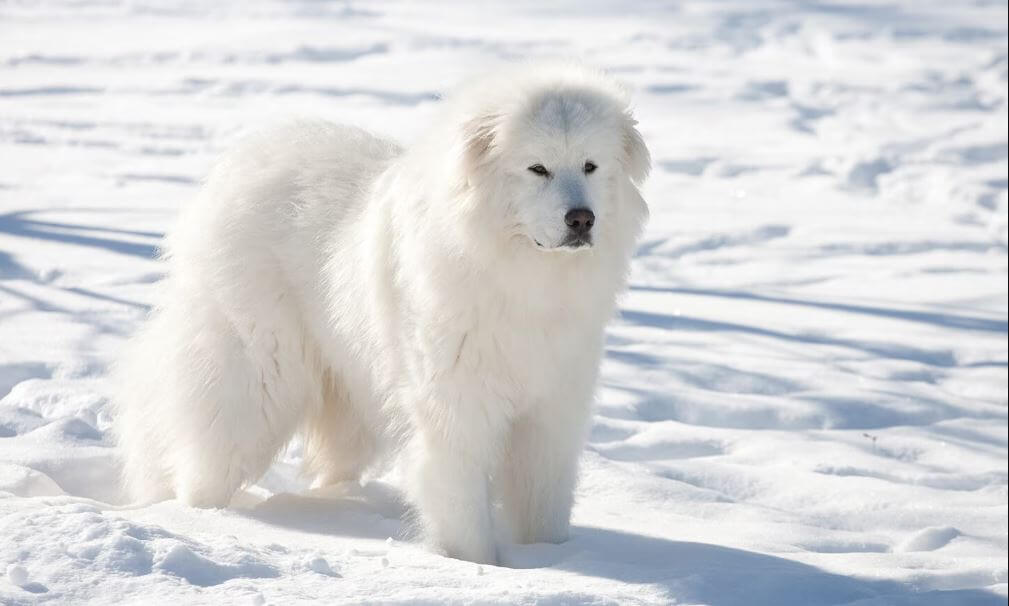
Great Pyrenees
The Great Pyrenees, also known as the Pyrenean Mountain Dog, is a majestic breed revered for its loyalty, intelligence, and protective instincts. Originating from the Pyrenees Mountains between France and Spain, this breed was developed to guard flocks and defend homes. Today, the Great Pyrenees continues to be a beloved companion and guardian in many households.
Appearance
The Great Pyrenees is known for its grand and imposing presence.
- Size: Males typically stand between 27 to 32 inches at the shoulder and weigh between 100 to 160 pounds. Females are slightly smaller, measuring 25 to 29 inches and weighing 85 to 115 pounds.
- Coat: They have a thick, weather-resistant double coat. The outer coat is long and coarse, while the undercoat is dense and woolly.
- Color: Predominantly white, with possible gray, tan, or reddish-brown markings.
- Distinctive Features: Their expressive dark eyes and powerful, well-balanced frame contribute to their noble appearance.
Temperament
The Great Pyrenees is known for its gentle and affectionate nature, particularly with family members.
Essentials for Your Newly Adopted Pet
Welcoming a shelter pet into your life is a beautiful journey. Here are some handpicked items to help your new friend feel safe, loved, and right at home:
- Protective and Loyal: They are highly protective of their family and territory, making them excellent watchdogs.
- Gentle with Family: Despite their size, they are calm and nurturing with children and other pets.
- Independent Thinkers: This breed is intelligent and can be independent or stubborn at times, a trait stemming from their history of working autonomously.
- Patient and Calm: The Great Pyrenees possesses a serene demeanor but will become assertive if they sense danger.
Exercise and Training Needs
While not overly energetic, the Great Pyrenees requires regular exercise to stay fit and healthy.
- Daily Walks: A couple of moderate walks each day or a large, secure area to roam and explore is ideal.
- Training Challenges: Due to their independent nature, training requires patience and consistency. Positive reinforcement is the best approach.
- Socialization: Early socialization helps them become well-mannered and less wary of unfamiliar situations.
Health and Lifespan
The Great Pyrenees is generally a healthy breed, though there are some conditions to be mindful of.
-
Common Health Issues:
- Hip Dysplasia: A condition affecting many large breeds.
- Bloat: Can be life-threatening and requires immediate attention if symptoms arise.
- Patellar Luxation: Occasional knee dislocation.
- Longevity: With proper care, the Great Pyrenees can live 10 to 12 years.
Grooming
Maintaining the Great Pyrenees’s beautiful coat requires regular grooming.
- Brushing: Weekly brushing is necessary to prevent mats and reduce shedding. During shedding seasons (spring and fall), daily brushing is recommended.
- Bathing: Only needed occasionally, as their coat naturally repels dirt.
- Ear and Dental Care: Regular ear checks and dental hygiene are essential to prevent infections and maintain oral health.
History and Background
The Great Pyrenees has a long history dating back thousands of years.
- Origins: Bred by shepherds in the Pyrenees Mountains for their strength, agility, and guardianship abilities.
- Noble Companions: By the 17th century, they were adopted as royal dogs in the court of Louis XIV.
- Modern Use: Today, they continue to be used as livestock guardians, therapy dogs, and loving family pets.
Ideal Living Environment
The Great Pyrenees thrives in homes where they have room to move and can stay mentally stimulated.
- Space Requirements: They do best in homes with large yards or rural properties. Apartment living can be challenging without ample exercise.
- Family-Oriented: Perfect for families that can provide love, attention, and boundaries.
- Climate Considerations: They handle cold weather exceptionally well but can overheat in hot climates, so proper precautions and shaded areas are necessary.
Fun Facts
- Mountain Guardians: The Great Pyrenees is one of the oldest breeds used for guarding flocks against predators.
- Gentle Giants: Their affectionate nature has earned them the nickname “gentle giants.”
- Unique Dewclaws: The breed often has double dewclaws on their hind legs, a distinctive trait thought to aid in climbing steep terrain.
Conclusion
The Great Pyrenees is a loyal and majestic breed that embodies both strength and gentleness. Ideal for families who appreciate their protective nature and can meet their grooming and exercise needs, these dogs make devoted companions and steadfast guardians.
Affiliate Products
Up to 75% Discount

Dog Collar with Health Monitoring
BUY NOW »
Up to 55% Discount

Luxury Faux Furhuge Napping Bed
BUY NOW »

